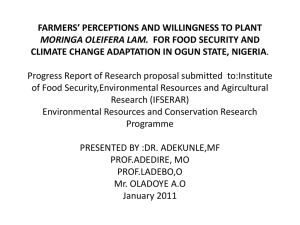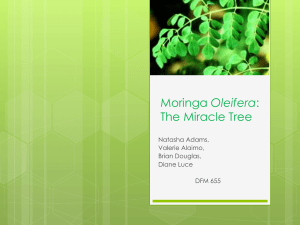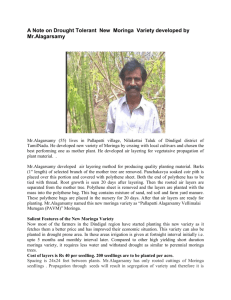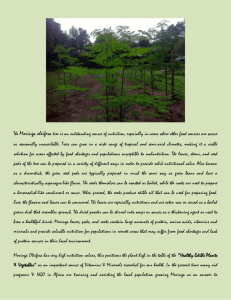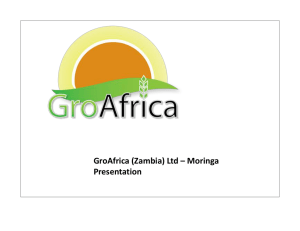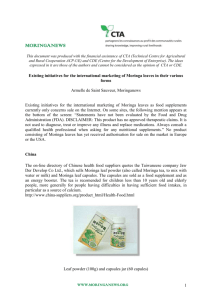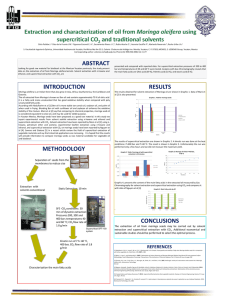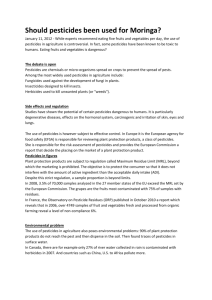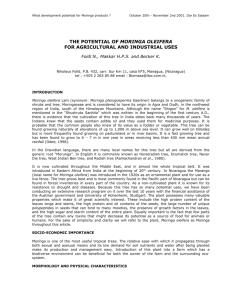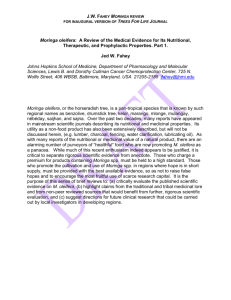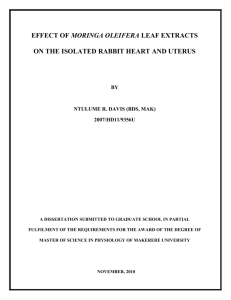Introduction - Moringanews
advertisement
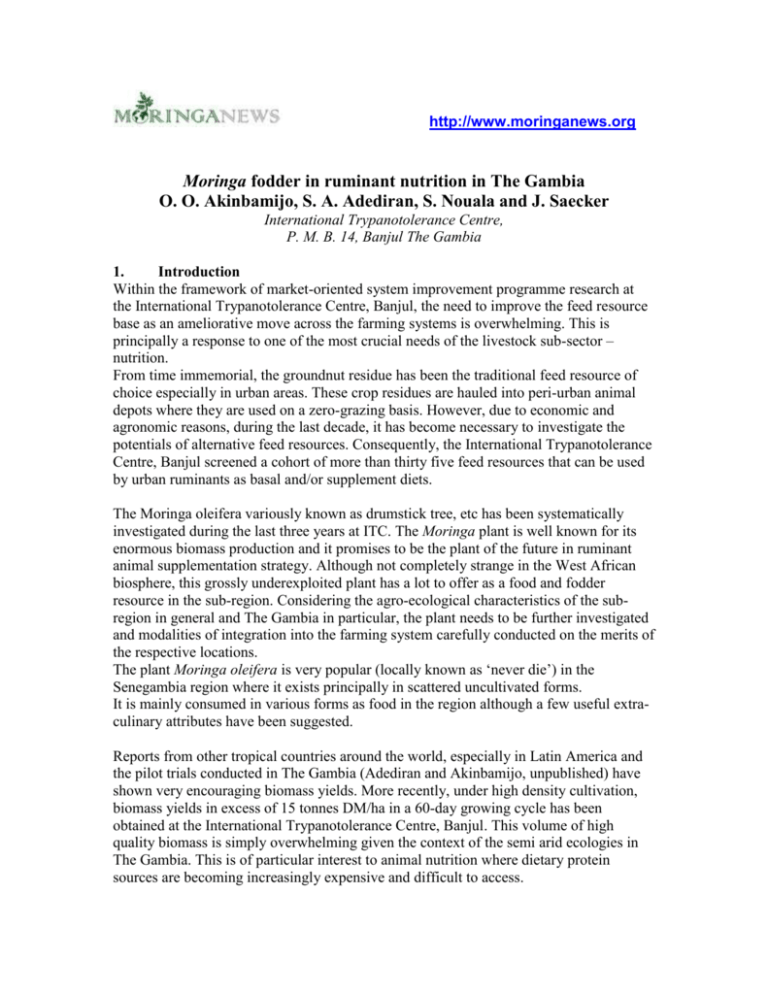
http://www.moringanews.org Moringa fodder in ruminant nutrition in The Gambia O. O. Akinbamijo, S. A. Adediran, S. Nouala and J. Saecker International Trypanotolerance Centre, P. M. B. 14, Banjul The Gambia 1. Introduction Within the framework of market-oriented system improvement programme research at the International Trypanotolerance Centre, Banjul, the need to improve the feed resource base as an ameliorative move across the farming systems is overwhelming. This is principally a response to one of the most crucial needs of the livestock sub-sector – nutrition. From time immemorial, the groundnut residue has been the traditional feed resource of choice especially in urban areas. These crop residues are hauled into peri-urban animal depots where they are used on a zero-grazing basis. However, due to economic and agronomic reasons, during the last decade, it has become necessary to investigate the potentials of alternative feed resources. Consequently, the International Trypanotolerance Centre, Banjul screened a cohort of more than thirty five feed resources that can be used by urban ruminants as basal and/or supplement diets. The Moringa oleifera variously known as drumstick tree, etc has been systematically investigated during the last three years at ITC. The Moringa plant is well known for its enormous biomass production and it promises to be the plant of the future in ruminant animal supplementation strategy. Although not completely strange in the West African biosphere, this grossly underexploited plant has a lot to offer as a food and fodder resource in the sub-region. Considering the agro-ecological characteristics of the subregion in general and The Gambia in particular, the plant needs to be further investigated and modalities of integration into the farming system carefully conducted on the merits of the respective locations. The plant Moringa oleifera is very popular (locally known as ‘never die’) in the Senegambia region where it exists principally in scattered uncultivated forms. It is mainly consumed in various forms as food in the region although a few useful extraculinary attributes have been suggested. Reports from other tropical countries around the world, especially in Latin America and the pilot trials conducted in The Gambia (Adediran and Akinbamijo, unpublished) have shown very encouraging biomass yields. More recently, under high density cultivation, biomass yields in excess of 15 tonnes DM/ha in a 60-day growing cycle has been obtained at the International Trypanotolerance Centre, Banjul. This volume of high quality biomass is simply overwhelming given the context of the semi arid ecologies in The Gambia. This is of particular interest to animal nutrition where dietary protein sources are becoming increasingly expensive and difficult to access. Given this magnitude of potentially useful biomass, there has been no systematic attempt to exploit Moringa either in terms of its agronomic attributes or its nutritional values. The preliminary investigations were therefore aimed at the systematic investigation of the nutritive evaluation and the modalities of establishing Moringa oleifera in the various farming systems in West Africa From the growing body of information on the plant, it is common knowledge that it is endowed with exceptional physicochemical properties with the possibilities of high biomass yield described above obtained at ITC. In addition, it is known to be devoid of any known anti nutritive factors and insignificant tannin contents. The plant is known contain at least 25% protein. Compared with other conventional ruminant feedstuffs in The Gambia, it has a very high biological value and considerable potential for adoption as food for humans as well as ruminant fodder resource 2. Systematic Investigations in The Gambia Since the beginning of the century, a new research strategy on the Moringa initiative was launched in The Gambia. This initiative received a lot of logistical support from the Institute for Animal Production in the Tropics and subtropics of the University of Hohenheim and the Church World Service, Dakar and the National Nutrition Agency of The Gambia. With the compelling attributes demonstrated in The Gambia, there was every reason to pursue the Moringa research plan in the context of the Senegambian faming system. Within this system, Moringa will readily fill both human and animal nutrition gaps. The ultimate beneficiaries therefore appear to be poor agro-pastoralists that need enormous food and feed support to keep their lives and those of their animals (upon which their livelihoods depend) in a sustainable manner. The nutritive value of Moringa oleifera is currently undergoing vigorous tests on-station and on-farm in parallel in the context of the West African farming systems and ecology. Agronomy The Moringa plant is cultivated in a high density mode with three approaches adopted in the evaluation of Moringa oleifera in the West African farming system context. The first step was the agronomic assessment of biomass yield under diverse production and harvesting regimes. Following the encouraging results obtained from a pilot study on Moringa oleifera establishment and yield at the International Trypanotolerance Centre, Banjul in 2001 with a planting density of 15cmX15cm, a logical next step was the determination of the optimum cutting height and intervals that would provide the best quality of fodder as well as retain the biomass yield at a relatively high level. In theory, we were to determine the maximum biomass yield without significant negative impact on the re-growth potential of the plant under reasonable conditions that can support regrowth. Three cutting heights – 20, 30 and 45 cm were tested in three cutting interval cycles of 50, 100 and 150 days after planting. Fodder was assessed for biomass yields, fibres and digestible nutrients. Biomass evaluation Biomass yield obtained by estimate dry matter content of the materials recovered in a 1 sq meter quadrat indicated the possibility of obtaining up to 20 tonnes DM/ha in a 50 day growing cycle. However, for the purposes of easy communication to the ultimate beneficiaries, it is recommended that the cutting cycle be rounded to once in two months rather than every fifty days. With a cutting interval of only 60 days before it is used as fodder, the nutritive value of the fodder is very high with very low chances of lignification. It must be stated however that optimum growing conditions such as continuous irrigation, high planting density and a fertiliser regime of 50 kg/ha/month are imperative before such high biomass yields can be obtained. In vitro Assays In order to improve our understanding of the nutritive value of Moringa, it was compared with other in vitro-simulated combination diets in a series of laboratory-based studies using the Hohenheim Gas Test method to quantify corresponding rumen gas production to Moringa-based diets. Emerging trends indicate that the Moringa option compared with groundnut cake, has a significantly higher gas production potential of up to 36 ml gas compared with 28 ml of VFAs at 40% inclusion in the diet (see figure 1 a & b). Using the Hohenheim Gat Test procedure, we have been able to improve our understanding on the comparative advantages of Moringa on groundnut hay. Figure 1 a&b: Gas production Co JexND Mo JexND 37.00 28.40 36.00 28.20 35.00 28.00 34.00 33.00 27.80 ml Gas ml gas 28.60 27.60 32.00 31.00 27.40 30.00 27.20 29.00 28.00 27.00 0% 10% 20% 30% 40% 100% Level 27.00 0% 10% 20% 30% 40% 100% level Ruminant Nutrition: High density nutrient supplementation strategy Moringa oleifera was investigated as an alternative to conventional concentrates in defining an appropriate supplementation strategy in a dairy production system using two classical methods: In vivo digestibility In vivo validation trial In addition, animal response on a trial diet using Moringa to supplement a groundnut hay- based diet has shown that there is no significant difference in performance when compared with animals supplemented with groundnut cake based concentrate. In a short term animal response study set up to validate the in vitro results using growing crossbred animals, in quantitative terms, animals offered Moringa leaves as supplements did attain a higher growth rate of 440 g/d compared to their counterparts offered conventional locally available concentrates (1:1 mixture of GNC and rice bran) that grew at the rate of 385 g/d although this difference did not attain statistical significance (Fig 2). As expected, the supplemented animals offered either Moringa or concentrate outperformed their counterparts offered only groundnut hay and gained only 274 g/d. The growth rate of the control animals was significantly lower than those of their supplemented counterparts. 3. Lessons learnt The present results confirms the enormous potentials of Moringa as a supplement for ruminants especially in highly intensive production systems such as the peri-urban dairy systems and as ameliorative dry season feeding strategy in the traditional extensive system of husbandry. Challenges Processing of biomass to avoid post harvest losses especially during the rainy season On-farm production will be a seasonal affair unless for exceptional cases where there are farmers that can afford to irrigate their Moringa fields. Our experiences in The Gambia with on-farm intensive production are that there is a high likelihood of excessive biomass yield during the rainy season. In order to optimize the exploitation of Moringa, the issue of fodder preservation becomes imperative in order to avoid post harvest losses. Efforts on how to address the perishability of the fodder is a current subject of research at the International Trypanotolerance Centre, Banjul. Storage for use during the dry season As on-farm production is geared toward food and feed, appropriate storage and methods and facilities have to be in place prior to harvesting. It is common knowledge that Moringa is a nutrient-rich supplement in terms of minerals and vitamins essential for vital physiological processes in humans and livestock. In order to avoid post harvest depreciation in the nutritive values of the nitrogen free extracts, there is need to provide adequate long-term storage facilities available to Moringa growers. Year round production in intensive systems In peri-urban dairy systems, where feeding is required to cater for the different phases of the dam cycle, appropriate cow nutrition becomes necessary. Land availability and communal ownership of high density Moringa fields The introduction of high density Moringa cultivation is still a novel approach to most of the end users. Although the plant itself is not new, the end users have never needed to have dedicated plots for growing Moringa in large quantities. As land tenure remains a big issue in areas where Moringa is most needed – especially as periurban feed resource, it is important that policy instruments in urban areas are formulated with feed resource concerns in perspective. In the rural areas where Moringa can greatly improve human and animal nutrition on community basis, there is need to adopt community forest ownership strategies to enhance the adoption and establishment of communal Moringa fields. 4. Concluding Remarks The predictions obtained under in vitro conditions were positively validated by growing bull calves. The implication is that high quality plant protein feed resource can be readily produced in a space pf two months. The possibility of replacing expensive groundnut cake with Moringa should be vigorously pursued. Performance of growing crossbred cattle offered Moringa supplements and other conventional supplements Live weight (kg) 150 130 Moringa GN Hay Concentrare 110 90 1 2 3 4 5 6 7 8 Weeks of experiment 9 10 11 12 13

